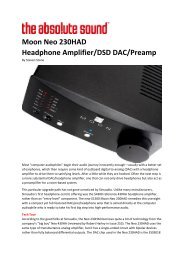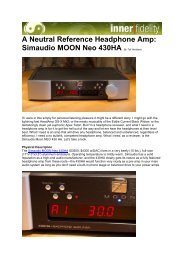You also want an ePaper? Increase the reach of your titles
YUMPU automatically turns print PDFs into web optimized ePapers that Google loves.
I was listening to a performance<br />
recorded in 1949!<br />
That, my dear readers, is<br />
the nature of this vivid French<br />
studio recording, the diminutive<br />
French songbird, and the<br />
sparkling brut clarity provided<br />
by the Moon Neo 340i driving<br />
the Magnepan .7s.<br />
Description<br />
One reason the Magnepan<br />
.7s played so well with the<br />
Simaudio integrated is that<br />
Magnepan speakers prefer<br />
amplifiers that double their<br />
rated output into 8 ohms<br />
when presented with a 4-ohm<br />
load—as does the Neo 340i,<br />
which is specified as producing 100Wpc into 8 ohms or<br />
200Wpc into 4 ohms. The Maggies’ infamous hunger for<br />
current was satisfied by the 340i’s ability to continuously<br />
deliver up to 30V at 12 amps, with 22-amp peaks. The Neo<br />
340i uses four bipolar transistors per channel, operated in<br />
class-A for the first 5W, and in class-AB for all subsequent<br />
joules per second.<br />
I am a slow-working audio reporter. I need months—<br />
Inside the Neo 340i: Note the<br />
four bipolar output transistors<br />
each side.<br />
1.89V at the line output, though with<br />
the volume control set to its maximum,<br />
digital data at –12dBFS resulted in a<br />
level just below clipping. The impulse<br />
response with 44.1kHz data (not<br />
shown) revealed that the Neo 340i’s<br />
reconstruction filter was a conventional<br />
FIR type with a sharp rolloff<br />
above 20kHz with 44.1kHz data (fig.1,<br />
red and magenta traces). The aliasing<br />
product of a full-scale tone at 19.1kHz<br />
at 25kHz (blue and cyan traces) is<br />
suppressed by 85dB, and the harmonics<br />
of the fundamental tone are all very<br />
low in level.<br />
Fig.2 shows the digital module’s fresometimes<br />
a year—to get a<br />
proper feel for a product.<br />
This is especially true with<br />
integrated amplifiers, because<br />
today’s models can be heavily<br />
laden with features, each of<br />
which takes time to appreciate.<br />
The Moon Neo 340i has<br />
been in and out of my system<br />
for more than a year—so<br />
long that I had to upgrade<br />
its DAC and firmware to<br />
finish this review. The basic<br />
340i, without phono stage or<br />
DAC module, can be had for<br />
$4700. Later, you can add a<br />
moving-magnet/moving-coil<br />
phono stage ($400) and/or<br />
a DSD DAC ($900). That’s<br />
$6250 for Lune à la carte.<br />
Or you can buy a 340i that<br />
includes all of these options—<br />
Simaudio calls the package<br />
the D3PX—for $5800. Simaudio sent me the D3PX edition.<br />
The Moon Neo 340i D3PX is a textbook example of a<br />
contemporary, top-quality, full-featured integrated amplifier.<br />
On its backside are four analog RCA inputs, one of<br />
MEASUREMENTS<br />
Iperformed a full set of measurements<br />
on the Simaudio<br />
Moon Neo 340i using my Audio<br />
Precision SYS2722 system (see<br />
the January 2008 “As We See It,”<br />
www.stereophile.com/content/measurements-maps-precision).<br />
I looked<br />
first at the behavior of the optional<br />
digital-input board, using either S/PDIF<br />
data sourced from the Audio Precision<br />
via optical or coaxial links, or USB<br />
data from my Mac Book Pro running<br />
on battery power. To avoid overloading<br />
the power-amplifier section, I switched<br />
the loudspeakers off and looked at the<br />
signals at the fixed line-output jacks.<br />
The TosLink input locked to data with<br />
sample rates up to 96kHz, the coaxial<br />
inputs to data sampled at all rates up<br />
to 192kHz. Apple’s AudioMIDI app<br />
revealed that the Neo 340i operated<br />
with 32-bit integer data at all sample<br />
rates from 32 to 384kHz. The USB<br />
Prober utility identified the Simaudio as<br />
the “MOON USB DSD HD Audio” from<br />
“Simaudio Ltd.,” and confirmed that<br />
its USB input operated in the optimal<br />
isochronous asynchronous mode.<br />
The digital input preserved absolute<br />
polarity (ie, was non-inverting) at both<br />
the line and speaker outputs. A 1kHz<br />
tone at 0dBFS gave rise to a level of<br />
d<br />
B<br />
r<br />
A<br />
d<br />
B<br />
r<br />
d<br />
B<br />
r<br />
A<br />
Fig.1 Simaudio Moon Neo 340i, S/PDIF input,<br />
wideband spectrum of white noise at –4dBFS (left<br />
channel red, right magenta) and 19.1kHz tone at<br />
0dBFS (left blue, right cyan), with data sampled at<br />
44.1kHz (20dB/vertical div.).<br />
Hz<br />
Fig.2 Simaudio Moon Neo 340i, S/PDIF input, frequency<br />
response at –12dBFS into 100k ohms with<br />
data sampled at: 44.1kHz (left channel gray, right<br />
green), 96kHz (left cyan, right magenta), 192kHz<br />
(left blue, right red) (0.5dB/vertical div.).<br />
Hz<br />
Fig.3 Simaudio Moon Neo 340i, S/PDIF input,<br />
44.1kHz data, spectrum with noise and spuriae of<br />
dithered 1kHz tone at –90dBFS with: 16-bit data<br />
(left channel cyan, right magenta), 24-bit data (left<br />
blue, right red) (20dB/vertical div.).<br />
Hz<br />
stereophile.com Q March 2016 87





